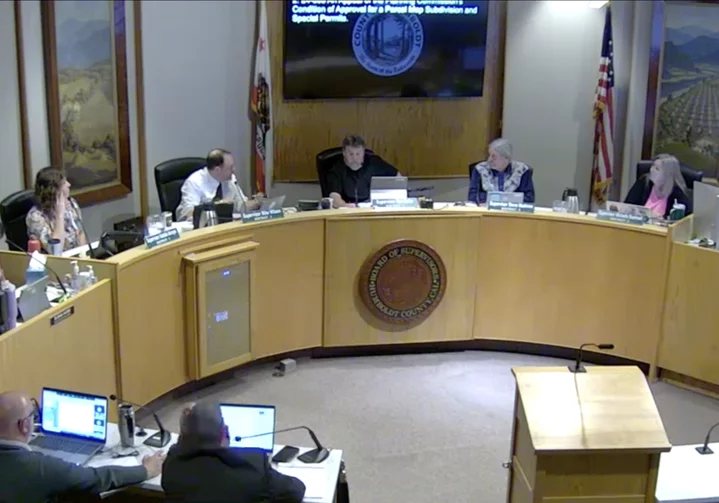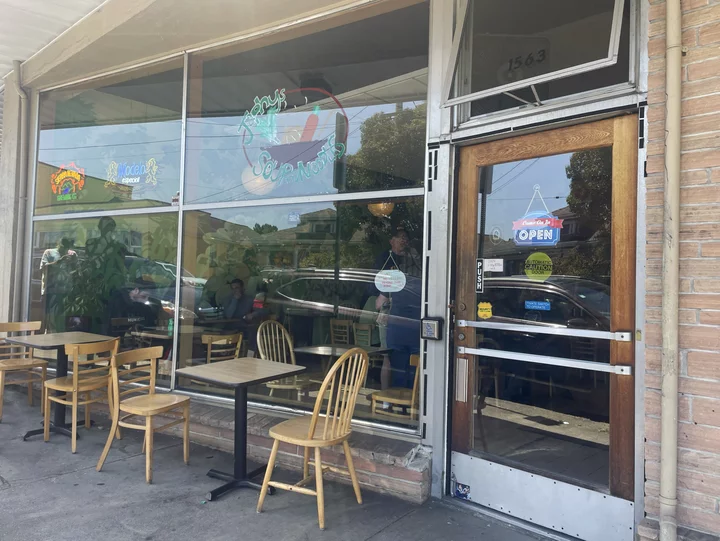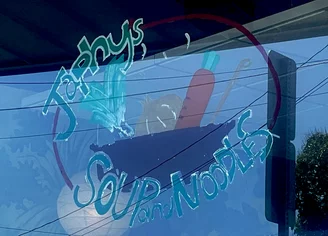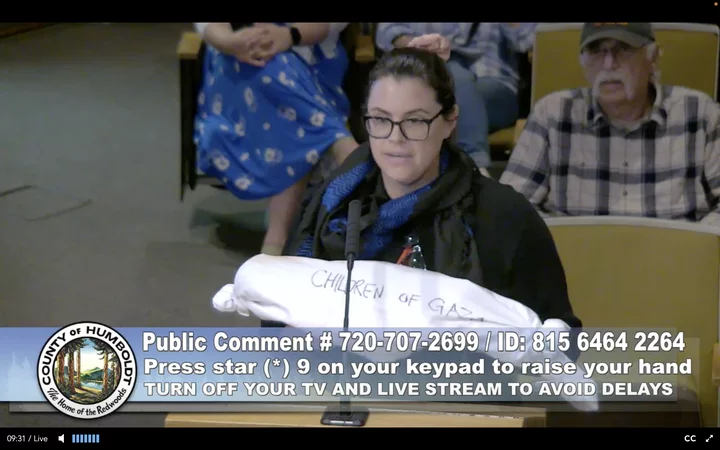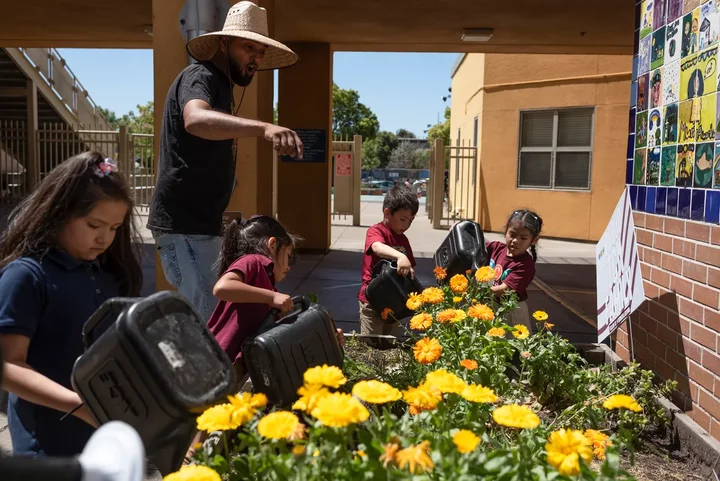Measles Update: The County Has Identified Everyone Who Was Exposed Earlier This Month; No New Cases to Report
Jacquelyn Opalach / Tuesday, May 21, 2024 @ 5 p.m. / Health
During a press conference today, Humboldt County Health Officer Doctor Candy Stockton said there are no new local cases of measles.
As of today, the Humboldt County Department of Health and Human Services (DHHS) finished contact tracing all 115 people who were potentially exposed to the disease on May 10, when someone with measles visited the Days Inn and St. Joseph Hospital emergency room in Eureka. It is believed that the infected person has left Humboldt County.
Those exposed aren’t in the clear yet, as symptoms could appear until May 31, Stockton clarified. DHHS is monitoring those individuals and is working with local healthcare facilities to spot measles symptoms should an infected person show up.
That said, most who were exposed are probably immune, which DHHS determined through interviews, vaccine records and some immunity testing. The vast majority are over the age of 30, and fewer than five are minors, Stockton said. Most of the 115 exposures happened at the hospital, and nearly half of the total exposures are health care workers.
“We’re very fortunate that most of those individuals who were exposed were over the age of 30, which is before a lot of the anti MMR [measles, mumps and rubella] vaccine misinformation that’s circulating really started to come into play,” Stockton said.
Vaccination is an effective defense against measles, preventing cases in 97 percent of people exposed. DHHS does not have immediate data on what percentage of Humboldt’s population is vaccinated for measles.
“It’s understandable that in this day and age, where many of us are not used to seeing these diseases, that the perceived risk of a vaccine can seem kind of scary. But the only reason we’re in this situation, where we can think the vaccine seems kind of scary, is because vaccines have been so effective at preventing these diseases. And so we no longer have pediatric hospital units full of children that are permanently damaged and/or dying from these vaccine-preventable illnesses,” Stockton said.
“I would love for us to learn from history and not have to learn from our own painful experience of watching our community members suffer from these diseases.”
Measles vaccines are typically administered to children in two doses, but adults who aren’t vaccinated or don’t know their status can get the jab as well.
Measles cases typically start with cold-like symptoms, which are followed by a red polka-dotted rash that usually starts at the top of the body and spreads downwards.
“At that point, you should call and check in with your healthcare provider to go through some questions over the phone to see if you might be at high risk and should be tested for measles or some other illness,” Stockton said.
“We ask that if you are developing symptoms that you think might be measles, please do not go into a healthcare facility unless you are so sick you need immediate medical support, because we don’t want to risk that spreading to other individuals – particularly in a healthcare setting – other individuals who might be immunocompromised and may not be able to fight off the virus if they’re exposed to it.”
If you think you might have measles but don’t have a healthcare provider, you can call DHHS at 707-268-2181 to get an over-the-phone screening.
“While I can never promise or guarantee that we won’t see cases, the odds are in our favor that this will not become an actual outbreak,” Stockton said. A measles outbreak is defined as three or more related cases.
BOOKED
Yesterday: 5 felonies, 11 misdemeanors, 0 infractions
JUDGED
Humboldt County Superior Court Calendar: Yesterday
CHP REPORTS
Us101 S / Davis St Ofr (HM office): Live or Dead Animal
ELSEWHERE
RHBB: Humboldt Partners Join Forces to Grow Next Big Business
RHBB: California Eyes November Special Election on Redrawing Maps Amid Texas Redistricting Moves
RHBB: Coast Guard Brings the Karolee to Humboldt Bay After Her Captain Disappears at Sea
Governor’s Office: Governor Newsom announces appointments
TODAY in SUPES: Board Tweaks Rules on Tobacco Sales, and Amid Disagreement, a Majority Approves Letters of Support for New State Water Regs
Ryan Burns / Tuesday, May 21, 2024 @ 4:55 p.m. / Local Government
The Humboldt County Board of Supervisors. | Screenshot.
###
If you missed our earlier post, the Humboldt County Board of Supervisors started today’s meeting by passing a Middle East peace resolution that calls for an “immediate and permanent ceasefire” in the Middle East as well as “mutual exchange of all hostages” and “respect for international law.”
Other matters on the agenda hewed closer to home. For example, the board unanimously passed some amendments to its Tobacco Retailer Licensing Ordinance, a set of rules it adopted last summer.
Sofia Pereira, the county’s public health director, said that the Division of Environmental Health has now processed nearly all of the 57 applications it has received from retailers looking to sell tobacco products under the ordinance, and 51 of those retailers have already passed inspection.
When the ordinance was first being considered last year, Second District Supervisor Michelle Bushnell voiced concerns about the economic impacts to local businesses. She said she’d heard from several small business owners in her district who objected to a provision that said tobacco products couldn’t be displayed within five feet of candy, snacks or nonalcoholic beverages.
Today, the board nixed that language and replaced it with a requirement that tobacco products be placed either behind a counter or in a locked case.
“This amendment still aims to address youth access to tobacco products and retail outlets and is really consistent with how almost all of the stores are already set up,” Pereira said. “Only six out of the 57 retailers would need to make minor adjustments.”
The ordinance passed last year also enacted restrictions on coupons and discounts on tobacco products, and with today’s vote the board passed an amendment exempting cigars, loose-leaf tobacco and flavored shisha (or hookah) tobacco products from those restrictions.
Bushnell again advocated on behalf of cutting costs for local small business owners, saying the $500 price tag to apply for and obtain a tobacco retail license from the county is “a really big hardship” for some in her district.
Third District Supervisor Mike Wilson later countered that, while he understands the concerns about retailer expenses, there’s also a community cost that comes with nicotine addiction. If distributing nicotine, alcohol and other unhealthy products is the only thing keeping retailers afloat, he said, “maybe we need to figure out a way to subsidize stores to have good products for our community.”
Water legislation letters
Earlier in the meeting, the board engaged a mildly contentious discussion about whether or not to send letters of support for two pieces of pending state legislation: Assembly Bill 460, which concerns enforcement of existing water rights law, and Assembly Bill 1337, which concerns the ways in which the State Water Resources Control Board regulates flows and enforces state water rights.
The letters of support were brought forward for consideration by Fourth District Supervisor Natalie Arroyo and Fifth District Supervisor Steve Madrone.
The board discussed the two proposed letters separately, though First District Supervisor and Board Chair Rex Bohn wanted nothing to do with either of them and he made that apparent from the jump.
“I can’t support [the letters of support] in any way because, basically, the Farm Bureau opposes it; my dairymen … they’re pretty much opposed to it,” Bohn said. “We’re doing a pretty good job of driving agriculture out of California.”
Arroyo and Madrone defended AB 460 specifically, with Madrone saying it would raise fines for illegal water diversions, which harm endangered species and impact other water users, including fishermen.
Leaders from several local and regional environmental organizations called or Zoomed in, urging the board to approve the letters. One local cannabis farmer, Craig Johnson, called in to voice opposition, saying the legislation could harm local ag producers.
After the public comment period, Bushnell joined Bohn in saying she won’t support the letters. But those two supervisors were outnumbered by the board’s progressive majority, with Arroyo, Wilson and Madrone all voting to approve sending the letter in support of AB 460.
The conversation about AB 1337 was similar, though it delved into the history of allocating water rights in the state. The bill would, among other things, clarify that the State Water Resources Control Board has the authority to curtail pre-1914 water rights.
“I think this is a good bill,” Madrone said. “It tries to level the playing field, and it basically says that if there’s not enough water to go around, everybody ought to be treated equally.”
Arroyo said the bill is designed to address the over-allocation of water in California, and she noted that the letter addresses the matter of equity in water rights.
“Prior to 1914, Black people couldn’t have water rights,” she said. “A lot of Asian people … who were, you know, part of the agricultural community, could not secure water rights prior to 1914. And many tribes could not, either.”
Regular public commenter Kent Sawatzky threw some shade toward Bushnell and Bohn for their reticence, saying, “I find it more than a coincidence that people connected with a certain business known as cannabis would be the main ones opposing this.” He also noted that the motions being considered merely “authorize” the board chair to sign the letters, rather than requiring it.
After another round of public comment — during which many of the same folks called in urging support — Arroyo said it had never even occurred to her to question whether the chair (Bohn) might decline to execute his authority, so she asked him directly: “If the board passes these letters, do you intend to sign and send them, Supervisor Bohn?”
Clearly offended, Bohn remarked that this is his third time around serving as chair, and if the majority of his colleagues ask him to sign a letter he would never refuse to do so. “It shouldn’t even be asked,” he said regarding Arroyo’s question.
Again, the vote was 3-2 in support, with Bohn and Bushnell voting “no.”
Following a closed session period and a break for lunch, Sawatzky called in to comment yet again, ostensibly about a resolution proclaiming May “Older Americans Month,” though he quickly turned to the tense exchange between Arroyo and Bohn.
Sawatzky accused Bohn of being “arrogant, ignorant and rude,” and he apologized to Arroyo on behalf of “old people.” He was in the midst of saying something about how Madrone ensured better decorum during his turn as chair when Bohn interrupted, saying it didn’t sound like Sawatzky was addressing the matter under discussion.
“Rex,” Sawatzky replied, “will you please quit interrupting me?”
“Probably not,” Bohn said.
Sawatzky admonished him again to stop interrupting, and as he continued to speak, Bohn apparently cut him off, muting the line on which he’d called in.
“I’ll catch hell for that,” Bohn remarked.
Someone else could be heard saying, “What — .”
“I don’t know what he’s talking about,” Bohn said.
After another moment or two, the clerk of the board un-muted the line and Sawatzky finished his comments, saying hopefully he won’t be interrupted the next time.
What else happened?
Glad you asked.
- The board had a prolonged discussion about whether or not to uphold a ruling from the Planning Commission requiring McKinleyville property owner Robert Sutter to construct a curb, gutter and sidewalk in order to complete a minor subdivision development. After discussing a variety of issues, including cost concerns, objections from neighbors and pedestrian safety, the board opted to require a separated asphalt walkway and cable fence as a condition for the Sutter Ranch Subdivision. Sutter deemed this a less onerous requirement than the sidewalk.
- The board approved a request to convert the 2,800-acre Marshall Ranch, located just south of Briceland, into an agricultural reserve.
- As alluded to above, the board proclaimed May as “Older Americans Month” and heard an update one the Area 1 Agency on Aging from its director, Maggie Kraft. She said the state is proposing cutting $111 million in funding for senior meal programs, which would amount to $850,000 in cuts for programs on the North Coast over the next three years. “That’s a lot of meals in our area,” Kraft said.
- Jade Hoff, the county’s Childcare Sustainability Program manager, delivered an update on the Childcare Stabilization Fund, which was financed via the American Rescue Plan Act (ARPA).
Japhy’s to Close its Doors After 25 Years
Jacquelyn Opalach / Tuesday, May 21, 2024 @ 2:51 p.m. / Food
Japhy’s Soup and Noodles | Jacquelyn Opalach
Japhy’s Soup and Noodles, the widely beloved soup joint on G street in Arcata, will close its doors for good this Thursday after 25 years of service.
The restaurant announced its closure Tuesday morning on its Instagram page.
“We want to express our sincere gratitude for choosing Japhy’s for over 25 years. We appreciate your patronage and value you as our customers,” the post said. “This Thursday will be our last day, as we are closing our doors for good. We hope to see you this week.”
The Outpost dropped by during a very busy lunch rush today to get the scoop. The manager didn’t want to do an interview, but we did catch a couple folks on their way in and out of the restaurant.
Eric Johnson, a regular at Japhy’s, was sad to hear the news.
“It’s a bummer. I remember when they first opened, I was skeptic of a little soup place like this, and it turned out to be really good,” Johnson said. “I would come here all the time because it’s really good, healthy food, and affordable.”
Suzy Haggerty, sitting outside waiting for an order of the Thai chicken curry, said Japhy’s will be missed. “We’ve been coming since they opened. We’re super sad – that’s why we’re here today. We just found out and came here.”
Haggerty noted that the restaurant’s mural and artwork will be missed as well, if it’s removed. The artist, Thao le Khac, painted the bountiful vegetable garden on one of the dining room’s walls shortly after the restaurant first opened.
Jahpy’s opened its doors in 1998 and switched ownership a few years ago. With gratitude, Johnson said that the new owners didn’t change much with the transfer. “I was stoked that somebody took it over, and they kept it the way it was,” he said.
If you want one last noodle bowl or a helping of that famous curry, Japhy’s will be open through Thursday. Their hours are 11:30 a.m.-8 p.m.
County Supervisors Pass Resolution for Peace in the Middle East, With Wording Taken From the City of Arcata
Ryan Burns / Tuesday, May 21, 2024 @ 1:25 p.m. / Local Government
During a public comment period, Eureka resident Shannon Townsend-Bettis displays a prop baby-sized body bag as she addresses the Humboldt County Board of Supervisors. | Screenshot.
###
As the International Criminal Court pursues arrest warrants for senior figures in the ongoing Israel-Hamas conflict, the Humboldt County Board of Supervisors took its own action this morning, passing a resolution that calls for an “immediate and permanent ceasefire” in the Middle East as well as “mutual exchange of all hostages” and “respect for international law.”
The wording of the resolution was borrowed from the City of Arcata, where the city council passed a re-worded statement in March after declining to even vote on an earlier iteration that included language specifically calling out Israel for its actions, such as the “collective punishment” of Palestinians.
The matter drew passionate public outcry at more than one meeting, and the version that was ultimately passed was drafted with help from extensive community outreach and participation.
Today, Fifth District Supervisor Steve Madrone, who brought the matter forward for the board’s consideration, spoke in generalized terms about conflict in the Middle East, saying that while the resolution will likely have very little impact on international events, he believes it’s important for the board to at least make a statement.
“This isn’t trying to take sides or to stir up any controversy or problem,” he continued. “It’s simply a statement of peace.”
If Madrone was hoping to leave the specific atrocities of the war in the subtext, public commenters proved more than willing to address them head-on.
Trinidad resident John Webb, for example, said that while Humboldt may be a tiny and remote community far from the conflict, “My taxes go to buy the bombs that are dropped on the civilian population of Gaza.”
Arcata resident Joanne McGarry, a regular advocate for the environment protections, said, “[I]t’s really, really important to those of us who really want peace in the world that our representatives respect that and and help us move in that direction.” She suggested that the title of the resolution should specifically mention the Israel-Palestine conflict.
Eureka resident Shannon Townsend-Bettis brought an infant-sized body bag to the dais. It has “CHILDREN OF GAZA” written across it and something inside (a doll, presumably) to make it look more convincing. She said that, through social media, the world is witnessing “an industrial slaughter of children” that’s unlikely to end soon because that would be “in contradiction with U.S. foreign policy.” She thanked the board for bringing the resolution forward and urged them to pass it.
Not all public speakers were in favor, however. Luta Belcher, a man who identified himself as a lifelong resident of Humboldt County and “a Hebrew” who briefly lived in Israel, spoke about the history of the region, including the rise to power of Hamas.
“Israel should be commended for its virtue in the way it’s executed this, not condemned,” Belcher said. “Our peace proposal doesn’t mention the return of the hostages that were taken, including American citizens. These people just want the bodies of their relatives, for crying out loud.”
When the matter came back to the board, Third District Supervisor Mike Wilson made a motion to pass the resolution, and Madrone seconded that motion.
Fourth District Supervisor Natalie Arroyo noted the long and complex history of the region, saying she’s working to educate herself on the pertinent issues. She noted that there’s “a lot of pain and frustration” in the community.
“I don’t think this [resolution] fully captures the full breadth of people’s perspectives or feelings about it, but I believe it’s a fairly content-neutral but important statement to make.”
Second District Supervisor Michelle Bushnell disagreed, saying that while she supports “the peace statement,” she thinks the resolution “doesn’t capture everything.”
“Like Supervisor Arroyo said, there’s a lot of history and a lot to know and a lot to learn,” Bushnell said.
First District Supervisor Rex Bohn described the resolution as “benign” to the point of being virtually without substance.
“There isn’t anything you can stick your fork into on this,” he said. He later described the resolution as “tapioca” and scoffed at the notion that either Hamas or Israeli President Benjamin Netanyahu will care about it. But he went on to vote for it on the grounds that it might make somebody out there “feel more comfortable that they’ve done their part.”
Arroyo, Madrone and Wilson also voted “yes,” and thus the motion passed 4-0-1, with Bushnell abstaining.
###
DOCUMENT: Resolution for Peace in Response to the Middle East Crisis
Two Stung During Underage Alcohol Sales Sting in Eureka Last Week
LoCO Staff / Tuesday, May 21, 2024 @ 9:12 a.m. / Crime
Press release from the Eureka Police Department:
The Eureka Police Department along with agents of the California Department of Alcoholic Beverage Control (ABC) conducted minor decoy operations resulting in two citations for selling alcohol to minors on May 14, 2024. The actions were the result of a Minor Decoy operation in which minors under the direct supervision of department agents, attempted to purchase alcohol from 19 retail licensees in Eureka.
Clerks who sell to a minor face a minimum fine of $250, and 24 to 32 hours of community service for a first violation. In addition, ABC may take administrative action against the alcoholic beverage license of the business where alcohol was sold to a minor. That may include a fine, suspension, or the permanent revocation of the license.
“Conducting these operations helps us increase public safety as well as reduce underage drinking.” said Chief Brian Stephens.
“Businesses should always check IDs before selling alcohol,” said ABC Director Joseph McCullough. “Preventing access to people not old enough to legally purchase alcohol improves safety on our roadways and in our communities.”
Statistics have shown that young people under the age of 21 have a much higher risk of being involved in a crash than older drivers. About 25 percent of fatal crashes involve underage drinking according to the National Highway Traffic Safety Administration (NHTSA).
Minor Decoy operations have been conducted by local law enforcement throughout the state since the 1980s. When the program first began, the violation rate of retail establishments selling to minors was as high as 40 to 50 percent. When conducted on a routine basis, the rate has dropped to below 10 percent in some cities. In 1994, the California Supreme Court ruled unanimously that use of minor decoys is a valid legal tool of law enforcement to make sure that licensees are complying with the law.
Funding for this program was provided by a grant from ABC through the department’s Alcohol Policing Partnership (APP) program.
Scorching Schoolyards: California Groups Want More Trees, Less Asphalt at Schools
Alejandra Reyes-Velarde / Tuesday, May 21, 2024 @ 7 a.m. / Sacramento
Advocates say California’s public schools lack outdoor shade to protect students from the sun and heat. Students from International Community Elementary School and Think College Now Elementary School water flowers at the César E. Chávez Education Center’s living schoolyard in Oakland on April 29th, 2024. Photo by Laure Andrillon for CalMatters
Schoolyards are hot and getting hotter, but only a tiny fraction of California’s grade school students can play in the shade.
Researchers and advocates are pushing the state to allocate money for green schoolyards, which can include trees, grass or gardens in place of the flat asphalt or rubber play surfaces at most schools.
With the help of more than $121 million in state grants, 164 schools already are on their way to either designing or building green schoolyards. Many more applied for the school greening grants, with requests totaling more than $350 million for projects they hoped to build.
The high applicant numbers highlight growing demand for greenery at schools as the climate gets hotter. But with California’s Green Schoolyards program depleted and a state general budget deficit of $56 billion over the next two fiscal years, where will the money for green school projects come from?
Some environmental groups are pushing for a proposed climate bond that would include $350 million for the green schoolyards program. They also are pushing for a $1 billion carve-out in a proposed $14-$15 billion school infrastructure bond that could go before voters this November.

Students from International Community Elementary and Think College Now Elementary play during recess in Oakland on April 29, 2024. Advocates say millions of children lack outdoor shade at California’s public schools. Photo by Laure Andrillon for CalMatters
“It is well known that our K-12 schoolyards, play structures and campuses are among the most dangerous climate liabilities currently facing the state — principally due to the deadly heat and flood potential our kids are being exposed to now,” environment groups wrote in a letter to authors of two school infrastructure bond proposals, Assemblymember Al Muratsuchi, a Democrat from Torrance, and state Sen. Steve Glazer, a Democrat from Orinda.
Muratsuchi told CalMatters he is reluctant to dictate how schools should use bond money.
“I’m aware of their request, but we have many other requests to consider,” he said, such as funds for heating and air conditioning systems and solar energy on campuses. “But those priorities will be defined by local school districts.”
Students need outdoor shade
On a typical 90-degree day under full sun, grass can reach 95 degrees, while asphalt can hit 150 and rubber surfaced play areas can reach 165 degrees, according to research by the UCLA Luskin Center for Innovation.
Forget 90 degrees; other research predicts much of the country is on track for more than double the usual number of 100-degree days by midcentury. Fresno already averages 33 days of 100+ degrees each year, Sacramento has 19 and Riverside has 14, federal weather data shows.
Unrelenting sun and high heat are bad for kids, the Luskin Center says: “Playing outside in the heat can lead to dehydration, headaches, heat stroke and other health impacts.”
Shade from trees is one of the best ways to cool things down, the researchers said, because it can reduce heat exposure to children by as much as 70 degrees.
But most of California’s schools lack tree canopy, and the trees that do exist on campuses are often around the perimeter, where students can’t access their shade during recess.
Green Schoolyards America, a nonprofit dedicated to building more green space on campuses, recently conducted a study of the tree canopy shading the state’s more than 10,000 public schools.
It found that an average of 6.4% of the school areas students access are covered by tree shade. More than 2.5 million students attend schools with less than 5% tree canopy in student areas.
That’s a far cry from what urban forestry and climate experts recommend. They say there needs to be enough trees to cover 30% of every city. Driven by that goal, Green Schoolyards America is pushing for ways to plant trees to cover at least 30% of each school area used by children during the day.
So far only 29,452 California students have that level of tree canopy, out of nearly 6 million students.

The schoolyard at the César E. Chávez Education Center in Oakland, prior to the creation of a ‘living schoolyard’. Advocates say most of California’s public schools lack trees or other outdoor shade sources, leaving millions of students vulnerable to heat and sun. Photo by Angela DeCenzo, Trust For Public Land
“This is a long-term infrastructure problem,” said Sharon Gamson Danks, chief executive of Green Schoolyards America.
“It’s not building a little garden in the corner. It’s actual infrastructure, on par with highway building. It’s an investment, and we want children to not be overlooked in preparing for climate and protecting their health.”
Most greening projects on school campuses include more trees, but they can also include mulch, grassy fields to replace asphalt, and wooden play and learning structures, said Šárka Volejníková, the Trust for Public Land’s program director for Bay Area parks.
The difference green space makes
At the César E. Chávez Education Center in Oakland, students — many from low income families — used to play on a yard that was 90% asphalt. The school is surrounded by freeways and industrial factories, and students suffer with high asthma rates, said Eleanor Marsh, the school’s former principal.
“In lower income areas the schools have more concrete,” Marsh said. “That is just the reality. And in higher income areas, kids have more natural play structures that have been fundraised for by PTA’s. It becomes an equity issue around mental health and access to core academics.”
The school received a $1.2 million grant from the California Natural Resources Agency’s Urban Greening program and worked with the Trust for Public Land in 2020 to completely renovate the schoolyard, adding more greenery, trees and play structures that would be cooler and more academically enriching.
Students were part of the process, taking the temperature of the asphalt and rubber playground and recommending alternatives.


First: José Luis Rodriguez teaches fifth-grade students about gardening. Groups want more outdoor shade at schools. Last: Students plant succulents at the César E. Chávez Education Center’s living schoolyard in Oakland on April 29, 2024. Photos by Laure Andrillon for CalMatters
Now students take outdoor gardening classes and play and run through their new “river” made with bricks, which doubles as a stormwater runoff system on rainy days.
There’s no lack of enthusiasm for greening projects among educators, said Marsh, now principal at San Pedro Elementary School in San Rafael.
“Every public school in California is up against huge budget cuts,” she said. “There is no money at the school site level to improve the physical space for students. So we are really relying on support from the state.”
Where the money could come from
The time to dedicate more funding to green schoolyards is now, said Manny Gonez, director of policy initiatives for the Beverly Hills environmental group TreePeople.
The latest proposals for a climate bond, which would be paid off over many years, includes an ask for $150 million for an urban greening grant, which doesn’t exclusively fund school greening programs but has in the past. TreePeople also supports the request for $1 billion in the proposed school infrastructure bond.
“Ultimately the priorities for school facilities funding should be driven by educators and not by the environmental lobby.”
— Assemblymember Al Muratsuchi, Democrat from Torrance
Traditionally school bonds are for new school construction or renovation. School districts can apply for the state bond funds for projects and must provide local matching funds. There is money set aside for financially strapped districts that can’t provide as much of a local match.
“This is a small down payment to really scale up the work that the state has been doing with these 164 schools,” Gonez said, referring to schools that already have green schoolyard grants.
The Trust for Public Land wants money set aside for green schoolyard projects and for the most needy schools to get priority, said Juan Altamirano, the group’s director of government affairs.
Earmarking the funds in the proposed school bond would boost support for the measure overall, Altamirano said. California voters — even those without children — support more green schoolyards, an April survey of 800 voters by the Trust for Public Land showed.
Some legislators were noncommittal when discussing the request.
Muratsuchi said he has been an environmental champion in the Legislature and understands the need for more green school funding. But in this case, it’s not up to him to define that as a priority in the school infrastructure bond.
“Ultimately the priorities for school facilities funding should be driven by educators and not by the environmental lobby,” he said.

Students in International Community Elementary and Think College Now Elementary play soccer during recess on an unpaved surface at the César E. Chávez Education Center’s living schoolyard in Oakland, California, on April 29th, 2024. Unpaved surfaces let water filter into the ground and reduce air temperature. Groups also want more outdoor shade at schools. Photo by Laure Andrillon for CalMatters
Glazer denied Calmatters’ request for an interview, saying he is not directly involved in the decision making of this issue.
California already has committed to increasing the tree canopy on schoolyards on paper, but how that will happen is unclear.
In the state’s Nature-Based Solutions Climate Targets published in April, officials said the state would prioritize greening schoolyards through its School Facility Program, “ensuring greening schoolyards is not just a consideration but an integral expectation when local educational agencies undertake new school construction projects and modernization projects.”
Gov. Gavin Newsom’s office did not answer questions about plans to fund greening school projects. Alex Stack, a Newsom spokesperson, said “No other governor has done as much as Gov. Newsom to protect people from extreme heat.”
Stacks said the green schoolyard grants already allocated are part of Newsom’s 2022 Extreme Heat Action Plan, funded by $52.3 billion in the California Climate Commitment budget.
Newsom cut the climate budget, and other parts of the budget, by more than 7% in his May revised proposal.
###
The CalMatters Ideas Festival takes place June 5-6! Find out more and get your tickets at this link.
CalMatters.org is a nonprofit, nonpartisan media venture explaining California policies and politics.
OBITUARY: Sara Jacy Guffey, 1992-2024
LoCO Staff / Tuesday, May 21, 2024 @ 6:56 a.m. / Obits
Sara
Jacy Guffey was born in Arcata on July 30, 1992 to Derek & Sharon
(Sherry) Guffey. Sara grew up in McKinleyville and during her
childhood she spent countless hours with her grandparents and aunt,
uncle
and cousins.
Her Grandma
Dee Dee and Papa
Tom operated an assisted living care home for the elderly, where Sara
would spend many hours mingling and bonding with the elderly ladies.
Later in life Sara would say that she believed this time spent with
the ladies at the care home resulted in her love of working with the
elderly. She also spent many hours with her Grandma Reen and Papa
Dan. We didn’t know it at the time, but she inherited much of her
sewing & crocheting talent from her Grandma Reen. Childhood time
spent with Auntie
Diane,
Uncle Randy and older cousins Rye Rye and Kyle were filled with
sports and goofing with the cousins who were made to “let her have
it” or “let her win.”
In grade school Sara’s closest friends were Gopika La Barge and Beatrice Cafe. Sara attended McKinleyville High School, where she made two very close lifelong friends, Mathew Woodke and Laura Erhard. After graduating high school Sara lived out of state for less than a year, then returned to McKinleyville. Once she was back Sara reconnected with family then began working a few different jobs including in home care, then as a nurse’s aid in convalescent homes. Sara then enrolled in the LVN program at College of the Redwoods, earned her Associate Degree LVN, passed her state exam and worked at Seaview Rehabilitation as a LVN Charge Nurse.
In the spring of 2020 at the age of 28 Sara purchased a home in McKinleyville where she lived with her partner Ben and his son Azmedaeus. In September Sara gave birth to her daughter Tilly, which she named after her great-grandmother Matilda (Tilly) Andrada, whom she shared a very special bond with. Sara worked and continued her education, then enrolled in the RN bridge program at CR which she began in the spring of 2023.
Sara loved being with family and she and Tilly would often spend the day at her parents home in McKinleyville. In the fall of 2023 when her parents, Grandma Dee Dee and brother Cole moved to Arizona, Sara (and Tilly) would replace those visits with nearly daily phone calls & facetime chats. Sara also routinely called her aunt’s and would talk for hours at a time with them. Sara had planned to complete the nursing program, take her state exam followed by a trip to Arizona where she hoped to move. Sara was only two weeks short of completing her RN schooling, but all together earned the following degrees at College of the Redwoods; Liberal Art Degree in Science Exploration, Associate Degree LVN, Associate Degree LVN/Paramedic to RN Mobility.
Sara was a proud, loving and devoted mother and leaves behind her beautiful three-year daughter Tilly; her parents Derek & Sherry Guffey; brother Cole Guffey; grandmother Delores “Dee Dee” Page. She also leaves behind her Auntie Diane Baxter (Randy), aunt Alice Tully (William), cousin Ryan Baxter (Tessa), cousin Kyle Baxter (Chelsey), great-aunt Evelyn Page (Gary), great-aunt Patricia Holtgrewe (Kenneth), great-aunt Debra Andrada (Cliff Bell) as well as many 1st and 2nd cousins. She also leaves behind her partner Benjamin Hungness and his son Azmedaeus Hungness.
She was preceded in death by her great-grandma Matilda “Tilly” Andrada, great-grandfather Anthony Andrada, grandfather Thomas Page, grandmother Maureen Guffey and grandfather Carl Dan Guffey.
Sara we hope you are at peace and surrounded by those that preceded you and love you.
A Celebration of Life will be held for Sara at 2 p.m., June 8, 2024 at the Moose Lodge, 1791 Sutter Rd, McKinleyville, CA, 95519. If you can bring a potluck dish it will be appreciated, however your presence is what’s most valued.
###
The obituary above was submitted on behalf of Sara Guffey’s loved ones. The Lost Coast Outpost runs obituaries of Humboldt County residents at no charge. See guidelines here.

